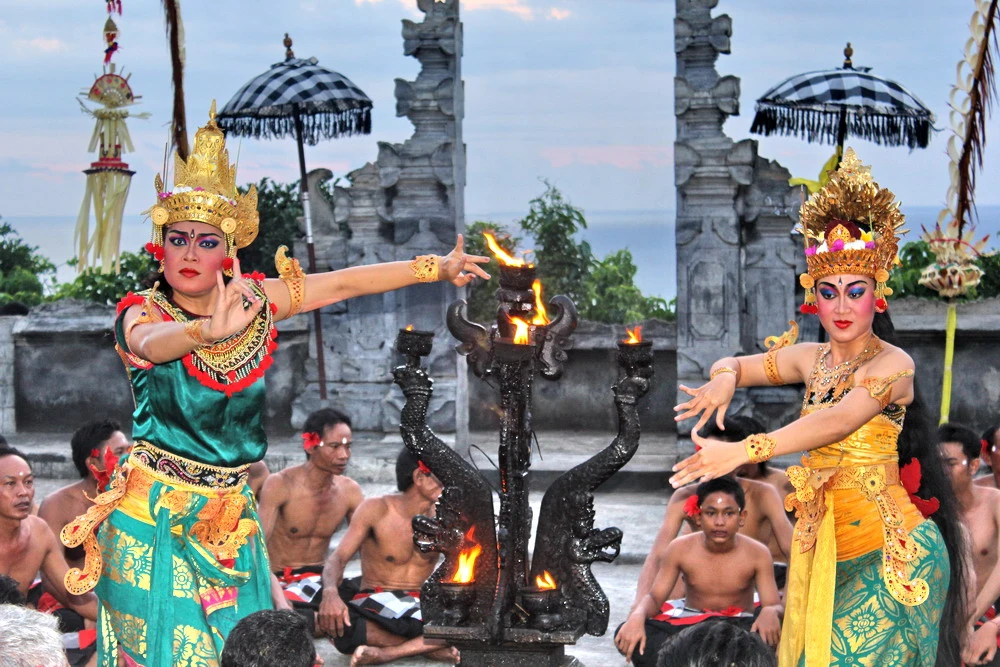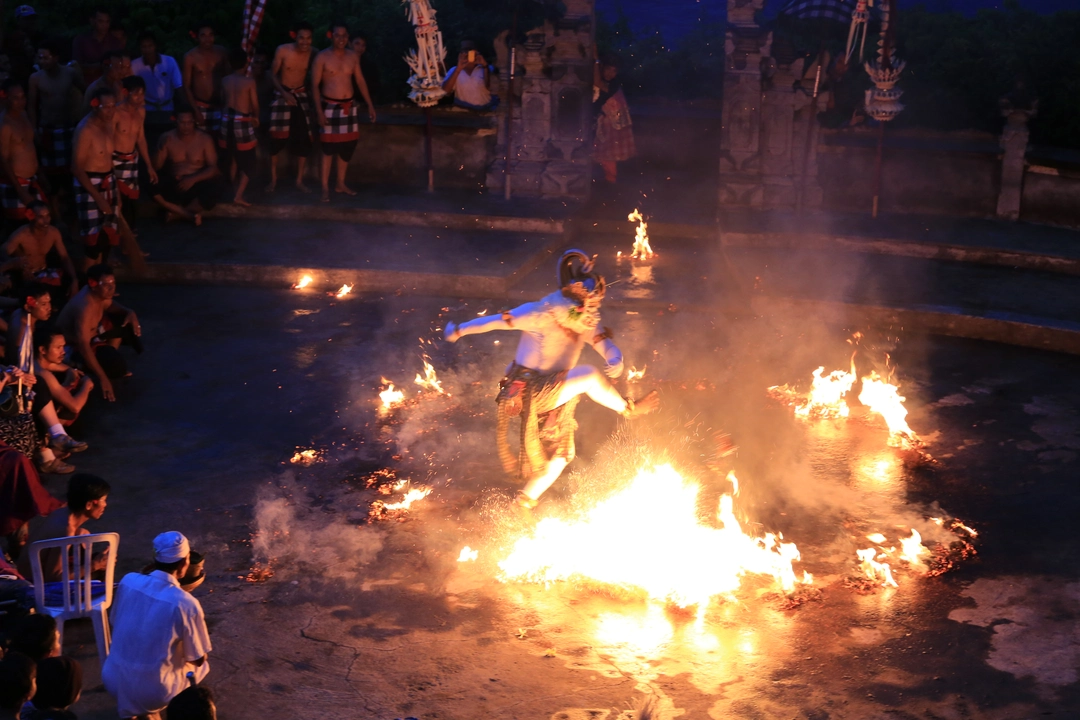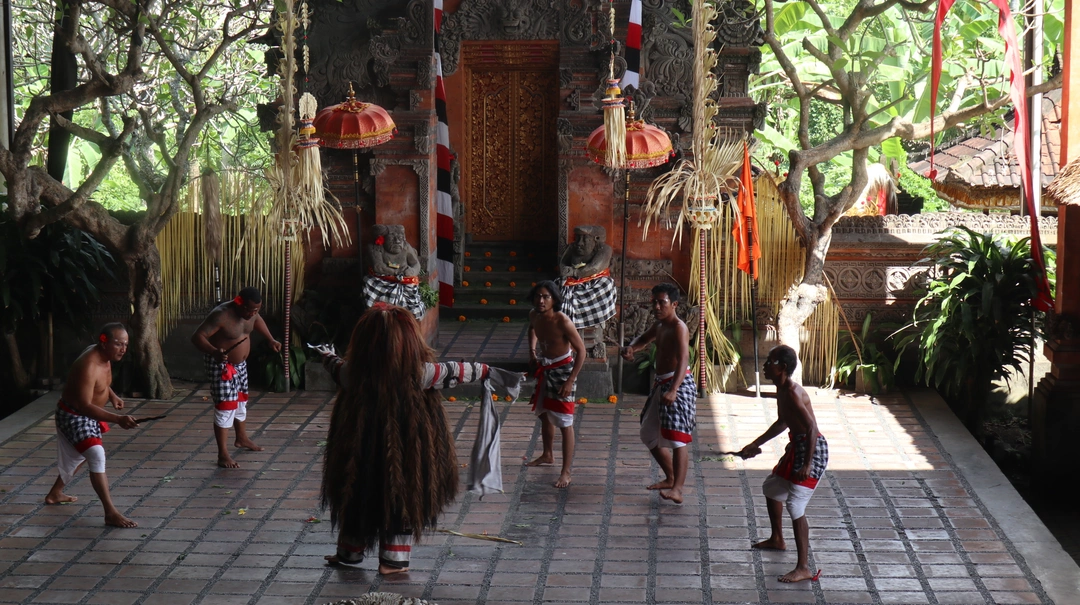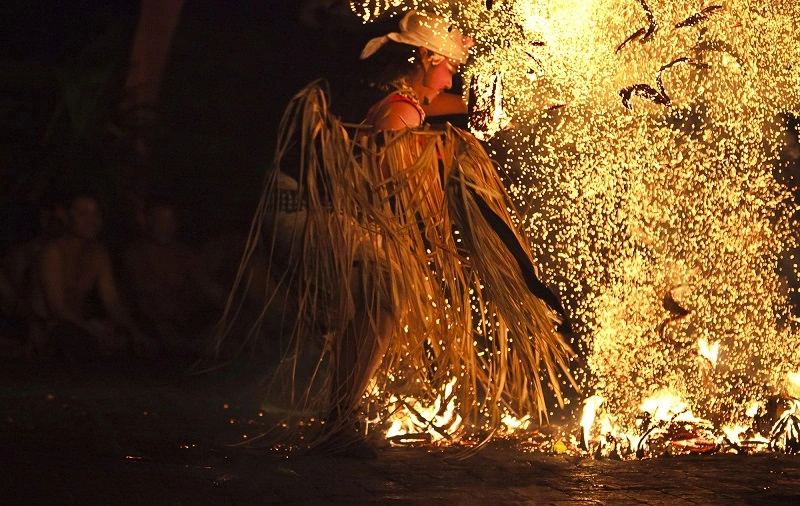If you’re a traveler eager to immerse yourself in Bali’s rich cultural heritage, experiencing traditional Balinese dance in Bali is a must.
These mesmerizing performances, filled with intricate movements and vibrant costumes, offer a deep connection to Bali’s ancient traditions. From the famous Kecak dance to the graceful Legong dance, Bali’s traditional dances provide a window into the island’s history and spirituality. In this blog, we’ll explore the top spots where you can experience traditional Balinese dance in Bali and get a closer look at its beauty and significance.
Kecak Dance at Uluwatu Temple: A Sunset Spectacle
Overview
One of the most iconic places to Experience Traditional Balinese Dance in Bali is at Uluwatu Temple, especially during the famous Kecak dance performance at sunset. Perched high on a cliff overlooking the Indian Ocean, Uluwatu Temple provides the perfect backdrop for the captivating Kecak fire dance. The performance, featuring a chorus of men chanting in rhythmic patterns, is both thrilling and spiritual.
.webp)
The Kecak Dance is one of Bali’s most iconic traditional performances, and its roots trace back to the island’s deep cultural and spiritual traditions. Unlike many other Balinese dances, the Kecak does not rely on musical instruments like gamelan. Instead, it features a chorus of men chanting “cak,” creating a rhythmic, hypnotic sound that forms the heart of the performance. This vocal chanting, along with dramatic movements, creates a unique atmosphere of intensity and spirituality.
What makes unique
The history of the Kecak dance is relatively modern, originating in the 1930s. It was developed by Balinese artists and scholars, particularly Wayan Limbak and Carl W. Von Puster, who were inspired by ancient Balinese rituals. They adapted a traditional trance ritual known as Sanghyang, where dancers would enter a trance-like state and perform, invoking spiritual forces. Over time, the performance evolved into a theatrical dance that told the story of the Ramayana, one of Bali’s key epics, specifically focusing on the episode of Rama’s battle with the demon king Ravana.

What makes the Kecak dance particularly unique is its dramatic, non-musical composition. The chorus of 50 to 100 men (known as the “cak” chorus) surround the audience in a circular formation, their voices building to a crescendo, creating an electrifying and otherworldly atmosphere. The chanting is not just an accompaniment but serves as a rhythm that drives the entire performance, accompanied by visual storytelling through dance and acting.

Another distinctive aspect of Kecak is its fire element. In the final scene, fire is introduced as part of the performance, often with dancers jumping through flames, symbolizing purity and spiritual power. This dramatic finale, combined with the stunning backdrop of Uluwatu Temple against the setting sun, makes it a once-in-a-lifetime experience for visitors.

In essence, the Kecak dance represents a perfect blend of spirituality, music, and drama, making it one of Bali’s most unique and unforgettable cultural experiences.
How to Get There
Uluwatu Temple is located in the southern part of Bali, about an hour’s drive from Kuta. It’s easily accessible by car, and it’s highly recommended to arrive early to secure a good spot for the performance.
Tips
- Arrive Early for the Best Seats: For the best view of the Kecak dance at Uluwatu, arrive early to secure a good spot. The temple can get crowded, especially during sunset performances.
- Wear Comfortable Footwear: Bali’s temples and cultural sites often involve walking on uneven terrain, so wear comfortable shoes to fully enjoy the experience.
- Check Performance Schedules: Performances like the Barong dance in Batubulan or the Legong dance in Ubud can have varying schedules. It’s a good idea to check times ahead of your visit.
- Bring a Camera: Balinese dance performances, with their vibrant costumes and dramatic storytelling, make for fantastic photo opportunities. Be sure to bring your camera!
- Respect the Local Culture: Balinese dance is deeply rooted in the island’s traditions and spirituality. Be mindful of local customs and behave respectfully during performances.
- Book in Advance: Especially during peak seasons, it’s recommended to book your tickets for dance performances in advance to avoid missing out.
- Beware of the Monkeys: Monkeys, especially at places like the Ubud Monkey Forest, can be curious and playful, but they might also grab food, bags, or loose items. Keep your belongings secure and avoid feeding them to prevent unwanted interactions.

Evening Traditional Dance in Batubulan: A Cultural Feast
Overview
For a truly authentic cultural experience, head to Batubulan, where you can enjoy an evening of traditional dance performances, including the famous Barong and Kris Dance. This dance depicts the eternal battle between good and evil, with vibrant costumes and dramatic movements that are sure to captivate you. The evening performances are held in open-air amphitheaters, offering a lively atmosphere that immerses you in the story.

What makes unique
The Barong and Kris Dance is one of Bali’s most beloved traditional performances, rich in cultural significance and history. It depicts the eternal battle between good and evil, with the Barong, a lion-like creature representing good, fighting against the Rangda, the witch-like figure symbolizing evil. The dance portrays the struggle for balance and harmony, a key theme in Balinese Hinduism.

The origins of the Barong dance date back to Bali’s ancient animistic traditions, where Barong was believed to be a protector of the village. Over time, this ritualistic dance evolved into the performance we see today, combining elements of religious ceremonies with storytelling. The dance itself is often accompanied by a vibrant display of traditional costumes, live gamelan music, and a colorful cast of characters.
The Kris Dance is an integral part of the Barong dance performance, where the dancers wield traditional kris daggers. The kris is an iconic blade, often seen as a symbol of power and spiritual strength in Bali. During the dance, the performers engage in a highly dramatic display of battle, with the Barong and Rangda each performing intricate movements that captivate the audience. The Kris dance often culminates in a trance-like state, with performers seemingly impervious to the sharp daggers as they engage in their spiritual battle.

What makes the Barong and Kris Dance so unique is its deep connection to Balinese mythology and Hindu beliefs. Unlike other traditional dances, it goes beyond entertainment, serving as a spiritual and religious performance that is meant to invoke blessings, protection, and purification for the community. The dance also showcases Bali’s rich cultural heritage, with every movement and costume carefully designed to represent certain symbols and meanings.
Performed in an open-air amphitheater, the Barong and Kris Dance immerses the audience in an atmosphere of drama and spirituality. The dramatic music, vivid costumes, and trance-like movements, combined with the lively environment of Batubulan, create an unforgettable cultural experience that is both captivating and meaningful. The dance not only entertains but also educates visitors about the fundamental beliefs and traditions of Bali.

How to Get There
Batubulan is located just a short drive north of Ubud, making it easily accessible from central Bali. Many tours include a stop here, so it’s easy to visit as part of a cultural day trip.
Tips
- Arrive a little early to take in the local atmosphere and enjoy a quick bite at nearby cafes before the show.
Wear Comfortable Clothing: Since the performance is held in an open-air amphitheater, it’s a good idea to wear comfortable clothing and bring a light jacket for the cooler evening temperatures.
Bring Cash for Souvenirs: Batubulan is known for its local handicrafts and souvenirs. Bring cash to purchase traditional Balinese items from the nearby vendors after the show.
Respect the Performers: Traditional dances like the Barong and Kris Dance are culturally significant. Show respect by refraining from talking during the performance and giving the performers your full attention.
Capture the Moments: The vibrant costumes and dramatic scenes of the dance make for excellent photo opportunities. Don’t forget your camera or phone to capture the magical moments.
Stay Hydrated: Bali can be hot, especially in the late afternoon. Be sure to drink plenty of water before heading to the performance, so you feel refreshed and ready to enjoy the show.

Legong Dance in Ubud: Grace and Elegance
Overview
Another top spot to experience traditional Balinese dance is in Ubud, the cultural heart of Bali. Here, you can witness the Legong Dance, a highly refined dance performed by young girls, characterized by delicate and graceful movements. The dance is accompanied by live gamelan music, making it a mesmerizing experience.
How to Get There
Ubud is about a 1.5-hour drive from Kuta or Seminyak. Ubud is well-connected by road, and many shuttle services are available for tourists.
Tips
Ubud Palace is a popular venue for Legong Dance performances, often held in the evenings.
Arrive Early for the Best Seats: Ubud Palace can get quite crowded, especially during peak tourist seasons. Arriving early ensures you get the best seats to fully enjoy the Legong Dance performance.
Check Performance Schedules: Legong Dance performances are usually held in the evening, but it’s always a good idea to double-check the schedule in advance to avoid missing out.
Wear Comfortable Clothing: The performance can last for about an hour, so wear comfortable clothing. Since the event is held outdoors, bring a light jacket for the cool evening breeze.
Bring Cash for Souvenirs: After the performance, there are often local vendors selling beautiful Balinese crafts. Bring cash to shop for unique souvenirs or art pieces.
Respect the Cultural Significance: The Legong Dance is deeply rooted in Balinese culture and spirituality. Be respectful by remaining quiet and attentive during the performance, and avoid using flash photography as it can disturb the dancers.
Take Photos, But Be Mindful: Feel free to capture the stunning costumes and graceful movements of the dancers, but be mindful not to block the view of other audience members or distract the performers.
Combine with Other Ubud Attractions: Ubud is home to many cultural sites and activities, so plan to explore other nearby attractions like the Ubud Monkey Forest or the Tegalalang Rice Terraces after the dance performance.
Book Your Traditional Balinese Dance Tour with Kura-Kura Bus
Bali offers a variety of opportunities to experience traditional Balinese dance, and the best way to ensure you don’t miss out on these amazing performances is by booking a guided tour with Kura-Kura Bus. Whether you’re visiting Uluwatu Temple to watch the Kecak Dance or heading to Batubulan for the Barong Dance, Kura2Bus offers convenient, comfortable transportation, and expert guides who can provide valuable insights into Bali’s cultural heritage.

Ready to experience Bali’s vibrant traditional dance performances? Book your tour with Kura-Kura Bus today and make your cultural adventure unforgettable!
Bali’s traditional dances offer a unique glimpse into the island’s rich cultural heritage, blending music, movement, and storytelling in mesmerizing performances. From the fiery Kecak dance at Uluwatu to the graceful Legong dance in Ubud, there’s something for every traveler to enjoy. Make sure to experience these unforgettable performances during your visit to Bali – book your tour with Kura-Kura Bus and enjoy a seamless and immersive cultural journey!

